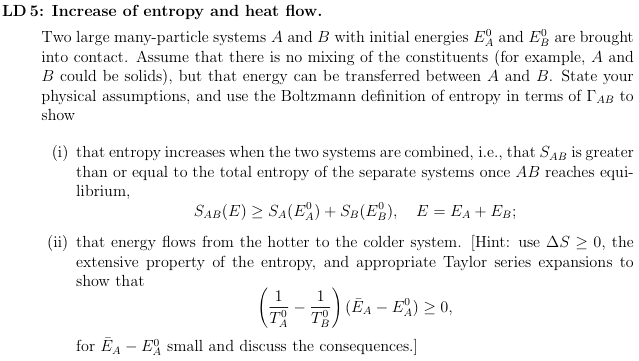
PROBLEM SET 2
Due Friday, February 3, 2006
Reading: Landau and Lifshitz, Chap. 2; Chap.3, Secs. 28-31

| Comments: Thermodynamics is not all about Carnot cycles, gases, and so forth. LD4 gives an interesting application in an unfamiliar
setting. Recall that once you have S(E), a temperature T can be defined.
Bekenstein actually demonstrated that the area A of the event horizon of a
black hole acts like an entropy, always increasing through interactions.
Hawking found the correct proportionality between S and A and then
demonstrated that a hot black hole must radiate, a result that would not
be surprising for a normal hot body, but one contrary to the usual
lore that nothing can escape from the black hole.
How long would a black hole of your mass last?
|
||
|
A complete quantum mechanical derivation of S for black holes was been obtained only recently using string theory [A. Strominger and C. Vafa, Phys.
Lett. B 379, 99 (1996)]. Strominger showed in addition
that information
is not lost at the quantum level when something falls into a black hole and
its energy reappears as thermal radiation. The information is
preserved near the event horizon [A. Strominger,
Phys. Rev. Lett. 77, 3498 (1996)]. |

| Comments: The results of this problem demonstrate that Boltzmann's entropy has the expected properties of the thermodynamic entropy defined by Clausius. The results can be extended to show that systems in equilibrium have equal chemical potentials, pressures, etc. |

| Comments:
The physical picture here is simple if possible multiparticle overlaps
or collisions are neglected. The number of three-particle overlaps at a
gas density n = N/V is proportional to n3/3! for N >> 1, so
should be negligible relative to the two-particle correction you are
asked to calculate provided n << 1 (low density).
The only sublety in the calculation is the need to factor out
Your result in this calculation is the hard-sphere version of the Saha-Bose equation of state. When corrected for the effects of longer range interactions, it is significantly better than the van der Waals equation of state with the same correction for gases near the critical point. |

| Comments:
This problem involves the definition of a distribution function in
one variable, here the energy E, by "integrating out" all the irrelevant
(unobserved) variables. We will encounter other such distributions, e.g.,
the two-particle Boltzmann momentum distribution, and the two-particle
cluster function, in later problems.
The calculations are rather simple if you observe that H is just the square p2/2m of a 3N vector in the 3N-dimensional momentum space, use spherical coordinates, integrate over the angles, and then change to the energy as the variable of integration. |